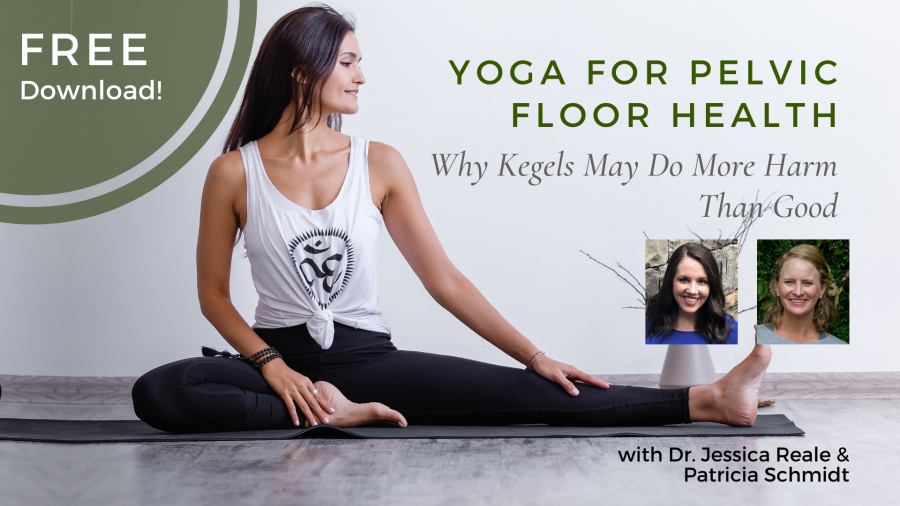Free Download! Yoga for Pelvic Floor Health: Why Kegels May Do More Harm than Good
Course Info
- Price:
- $0.00
Dr Jessica Reale and Patricia Schmidt
 Dr. Jessica Reale, PT, DPT, WCS
Dr. Jessica Reale is a Doctor of Physical Therapy (DPT) and Board-Certified Specialist in Women’s Health (WCS). She has specialized for over 10 years in working with all people with pelvic floor dysfunctions, and owns a private practice, Southern Pelvic Health, in...
Dr. Jessica Reale, PT, DPT, WCS
Dr. Jessica Reale is a Doctor of Physical Therapy (DPT) and Board-Certified Specialist in Women’s Health (WCS). She has specialized for over 10 years in working with all people with pelvic floor dysfunctions, and owns a private practice, Southern Pelvic Health, in... 
In seeking the cause of ailments such as back pain, constipation, or even dysfunctional breathing issues, the pelvic floor rarely shows up on the list of potential suspects. But physical therapist Jessica Reale and Yoga Educator Patricia Schmidt are on a mission to change that.
Jessica and Patty, both specialists in pelvic health, work collaboratively to help their clients with an approach that blends a more traditional physical therapy approach with a yoga practice to achieve a greater long-term outcome.
In this free download interview, Jessica and Patty start by dispelling the common misunderstanding that the pelvic floor muscles are akin to a simple hammock or sling sitting at the bottom of the “pelvic bowl.” In fact, a healthy pelvis is integral to overall health and wellness. And toward that end, yoga can play a key role.
Jessica explains how the traditional notion that pelvic floor problems such as incontinence are best addressed by working with the pelvic floor in isolation (think 50 Kegels a day) is changing.
“What we’ve learned about the pelvic floor is that it’s a system that does not work in isolation,” she says. Yoga offers a great alternative to working with pelvic floor balance, she notes, because it’s so much more holistic and comprehensive.
“I love the way yoga philosophy views the body and the way the yoga movements are tied into the breath and the nervous system. It was a really natural pairing with how I work with my patients,” says Jessica.
“The pelvic floor is absolutely fundamental to a well-functioning sense of self,” notes Patty when describing what brought her to this work.
Jessica goes on to cite studies that have shown how the pelvic floor coordinates synergistically and neurologically with the respiratory diaphragm.
“When we inhale the pelvic floor descends. And when we exhale both the pelvic floor and the respiratory diaphragm elevate,” she says. Those muscles partner with the deep abdominal and low back muscles and together they modulate pressure in the pelvis and the abdomen. They also act as anticipatory muscles, cueing the core muscles to adjust to any type of movement based on the task at hand.
Taking the bigger picture, Jessica and Patty show how the movement of the ribcage and even the vocal folds to movements of the foot can be tied to the pelvic floor. And they point out that pelvic floor health is not just about how strong the pelvic floor muscles are, but rather developing a strong, flexible, healthy system that functions well in a healthy system within the body.
While issues around fertility and post-natal fitness may be the first time some clients consider the role of their pelvic floor in overall health, Patty points out that the pelvic floor has a much greater impact. “We are born with a pelvic floor that takes on our family of origin, our movement patterns, repetitive movements in our childhood,” she says.
In fact, Patty says it’s not unusual for her to start working on pelvic floor issues from the shoulders. “When we are in the shoulders we’re in the pelvic floor; when we are in the thoracic space we are in the pelvic floor,” she states. “Because the girdles and diaphragms of the body mirror one another. Sometimes these systems are at odds, they don’t work optimally; this is often what inspires clients to seek ways to enhance wellness.”
This is where the collaboration between the PT and the Yoga excels. “When people go to pelvic PT they need to be in the pelvis,” Patty continues. “But one of the things that yoga can do is help them access the pelvis with different entry points. Like coming to the shoulder girdle and finding an entry there.” This is especially relevant to people living with trauma or in situations where discomfort around approaching the pelvis directly may be uncomfortable.
Jessica concurs and elaborates on the efficacy of yoga in long term pelvic health. “I can help my patients negotiate the activities of daily living such as lifting a child or sitting at a desk, with manual therapy that improves their soft tissue mobility or prescriptive exercises working with them once a week in the office.”
“But my long term goal is to help them more globally with their movement and fitting their pelvic floor into their body. My ultimate goal is to find a long-term practice for them that fits with their goals and that’s where yoga fits in so nicely.”
Click "Enroll Now" to Download!